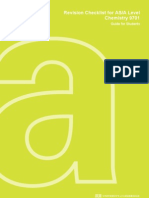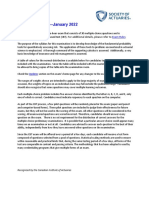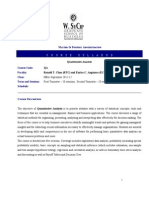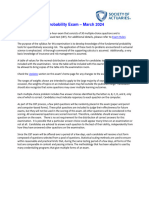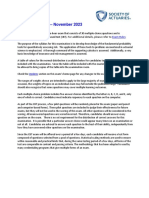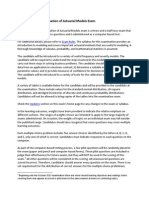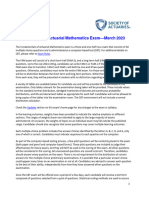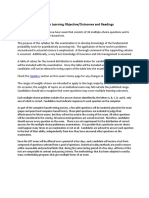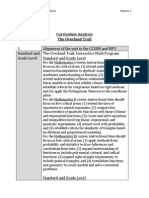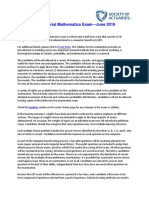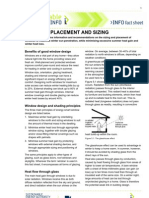Gis 2012 Paper Alina Pettifer
Gis 2012 Paper Alina Pettifer
Uploaded by
GABRIEL LUQUECopyright:
Available Formats
Gis 2012 Paper Alina Pettifer
Gis 2012 Paper Alina Pettifer
Uploaded by
GABRIEL LUQUECopyright
Available Formats
Share this document
Did you find this document useful?
Is this content inappropriate?
Copyright:
Available Formats
Gis 2012 Paper Alina Pettifer
Gis 2012 Paper Alina Pettifer
Uploaded by
GABRIEL LUQUECopyright:
Available Formats
Exam Content Outline
Modern Actuarial Statistics I (MAS-I)
Delivery Format
APPOINTMENT TIME: 4.5 HOURS
Exam Tutorial, Confidentiality
Exam Duration Scheduled Break Agreement, End of Exam Survey
4 hours 15 min 15 min
Exam Item Types
Candidates may see the following item types in the CAS examinations. Candidates should become
familiar with these item types and sample questions will be available in 2023.
Multiple Choice
Multiple answer choices are presented after a problem with only one correct answer.
Multiple Selection
Multiple answer choices are presented after a problem with more than one correct answer.
Point and Click
An image is presented after a problem where the candidate must identify the correct area of the image
by clicking on the correct location in the image.
Fill in the Blank
A blank section is presented after a problem where the candidate must input the correct value.
Casualty Actuarial Society Exam MAS-I Content Outline 1
Exam Cognitive Level
Each task is tied to a certain type of mental operation or thinking skill, which is called the cognitive level.
ACAS and FCAS use four cognitive levels, and every examination item is authored to address both the
task and one of the following cognitive levels paired with that task (sample questions coming soon).
Remember: 5-10%
Tests the ability of the candidate to recall or remember knowledge or facts.
Understand and Apply: 55-60%
Measures the candidate’s ability to understand and apply ideas and concepts to new situations.
Analyze and Evaluate: 35-40%
Requires the candidate analyze information, combine concepts/ideas, and justify a position resulting from
that combination.
Create: 0-5%
Requires the candidate to synthesize conclusions by evaluating the validity of ideas and concepts.
Casualty Actuarial Society Exam MAS-I Content Outline 2
Exam Section Details
DOMAINS DOMAIN
WEIGHT
A. Probability Models (Stochastic Processes and Survival Models) 20-30%
B. Statistics 20-30%
C. Extended Linear Models 45-55%
A. Probability Models (Stochastic Processes and Survival Models)
Candidates should be able to solve problems using stochastic processes and determine the probabilities
and distributions associated with these processes.
TASKS
1. Model claim frequencies using Poisson processes
2. Calculate expected values, variances, and probabilities for any Poisson process
3. Calculate limited expected value
4. Perform survival model and hazard rate calculations
5. Perform joint life calculations
6. Calculate simple whole life or annuity problems
Readings:
- Daniel
- Ross
- Struppeck
Casualty Actuarial Society Exam MAS-I Content Outline 3
B. Statistics
Candidates should be able to apply the concepts typically covered in the 2nd semester of a two-semester
undergraduate sequence in Probability and Statistics.
TASKS
1. Estimate the mean and variance given a sample
2. Estimate a sufficient statistic for a distribution
3. Test statistical hypotheses, including Type I and Type II errors
4. Test means and variances using critical values from a sampling distribution
5. Model insurance claim frequency and severity
6. Model insurance claims in aggregate
7. Calculate order statistics of a sample
8. Perform point estimation of statistical parameters using maximum likelihood estimation (MLE)
applying criteria to estimates such as consistency, unbiasedness, sufficiency, efficiency,
minimum variance, mean square error (e.g., accounting for censoring and truncation in the data)
9. Adjust calculations for the effect of missing data values, including censoring and truncation
Readings:
There are many good introductory statistics textbooks that do an excellent job of covering the
material on Section B. In the interest of clarity for the candidates, though, we have selected two.
- Hogg, McKean, and Craig
- Tse
Casualty Actuarial Society Exam MAS-I Content Outline 4
C. Extended Linear Models
Candidates should be able to solve problems using extended linear models and determine when these
models are appropriate to use.
TASKS
1. Select the appropriate model for an extended linear model
2. Select the appropriate model structure for an extended linear model given the behavior of the
data set to be modeled (e.g., appropriate link function and distribution for the dependent
variable for GLM)
3. Evaluate models developed using an extended linear model approach
4. Interpret the extended linear model output from statistical software, such as parameter
estimate tables and ANOVA tables
5. Distinguish among categorical, ordinal, and continuous predictors and their interactions, and
how these relate to their usage in an extended linear model
6. Understand and apply control and offset variables in GLMs
7. Understand and calculate AIC, BIC, deviance, and R-squared
8. Analyze model diagnostic plots (e.g., residual, marginal model, QQ, and added variable plots) to
assess quality of fit
9. Interpret exploratory data analysis plots for various data types (e.g., box, univariate, histograms)
Readings:
- Dobson and Barnett
- Hogg, McKean, and Craig
- James et al.
- Larsen
Casualty Actuarial Society Exam MAS-I Content Outline 5
Complete Text References for Exam MAS-I
Text references are alphabetized by the citation column.
Domains/
Citation Abbreviation Source
Tasks
Daniel, J.W., “Poisson processes (and mixture Daniel A1-5 OP
distributions),” CAS Study Note, June 2008.
Note: Practice Problems as noted in the paper's Foreword
are available on the CAS website.
Dobson, A., and Barnett, A., An Introduction to Generalized Dobson & C1-C9 B
Linear Models, 4th edition, Chapman and Hall/CRC Press, Barnett
2018.
- Chapters 1-9, excluding 6.3.3, 6.7, 6.8, & 7.9
Hogg, R.V., McKean, J.W., and Craig, A.T., Introduction to Hogg, B1-B8, B
Mathematical Statistics, 8th edition, Prentice Hall, 2018. McKean, and C1-C9
- Domain B: Sections 1.7, 2.7, 2.8, 3.7, 4.1, 4.4, 4.5, 4.6, Craig
4.7, 5.1, 6.1, 6.2, 6.3, 6.4, 6.5, 7.1, 7.2, 7.3, 7.4, 7.5, 7.6,
8.1, 8.2, 8.3
- Domain C: 4.4, 6.3, 6.5, 7.5, 9.1, 9.2, 9.3, 9.4, 9.5, 9.6
James, G., et al., An Introduction to Statistical Learning, with James et al. C1-C9 OP
Application in R, 2nd edition, Springer, 2021.
- Chapters 1, 2 (excluding Section 2.2.3), 3 (Sections 3.1
through 3.3, and 3.6 labs on Sections 3.1 through 3.3),
4 (Sections 4.1 through 4.4; the Linear Discrimination
Analysis portion of Section 4.4 will not be tested), 5, 6,
and 7
Larsen, M., “Generalized Linear Models,” CAS Study Note, Larsen C1-C9 OP
December 2015, revised June 2016.
Ross, S. M., Introduction to Probability Models, 11th edition or Ross A1-A6 B
12th edition, Academic Press (an imprint of Elsevier, Inc.),
2014/ 2019.
- Sections 4.1-4.8, 5.2.1-5.2.4, 5.3, 5.4.1, 5.4.2, 9.1-9.6, 11.1,
11.2.1, and 11.2.2
Struppeck, T., “Life Contingencies,” CAS Study Note, Struppeck A5-6 OP
October 2014, revised September 2015.
Tse, Y., Nonlife Actuarial Models, Theory Methods and Tse B1-B4, B
Evaluation, Cambridge University Press, 2009. B7-9
- Sections 1.1, 2.2, 2.3, 2.4, 2.5, 10.1, 10.2, 11.1, 12.1, 12.3,
13.2
Casualty Actuarial Society Exam MAS-I Content Outline 6
Supplemental Study Materials
The readings cited above are the expected readings that candidates should incorporate into their study
plans and represent the minimum study needed for this exam. The expected readings are also exclusively
used by CAS Subject Matter Experts who create the examination content.
In addition to the expected readings, candidates may consider the recommended information and readings
below to incorporate into their study plans. The recommended materials will provide candidates with helpful
knowledge to perform the exam tasks.
Parameter and Diagnostic Tables
Exam questions may contain parameter tables and diagnostic tables or plots of the type shown in the
texts. Candidates should understand how to interpret these tables. Candidates who become familiar with a
statistical language capable of generating this type of output, such as R, will have an easier time
understanding and applying the concepts covered in the exam material. In particular, candidates that work
the lab exercises at the end of the chapters in the James, Gareth, et al. textbook will have a better grasp of
the material than that obtained by simply reading the textbook. However, for exam questions, candidates
will not be asked to write or interpret R code.
GLM Problems
Candidates are encouraged to seek out examples of GLM problems to enhance their understanding of
GLM concepts. Candidates will not be tested on concepts that are outside of the scope of the required
reading that may appear in those examples. The examples are furnished so that candidates might reinforce
concepts covered in the Dobson and Barnett textbook.
Casualty Actuarial Society Exam MAS-I Content Outline 7
Additional Problems and Examples, Section B and C
Domain B
For those candidates who would like to work additional problems or see additional examples to illustrate
the concepts in Section B, a couple of sources are listed below that are from the Schaum’s Outline series.
We are not expanding the range of material covered and only mention these additional sources as a study
aid.
- Schiller, Spiegel, and Srinivasan: Chapters 4-9
- Spiegel and Stephens: Chapters 8-12
Domain C
For those candidates who would like to work additional problems or see additional examples to illustrate
the concepts in Section C, a couple of sources are listed below that are from the Schaum’s Outline series.
We are not expanding the range of material covered and only mention these additional sources as a study
aid.
Domains/
Citation Abbreviation Source
Tasks
Salvatore, D., and Reagle, D., Schaum's Outline of Statistics Salvatore C/1-4 BO
and Econometrics, McGraw-Hill, 2nd edition, paperback,
January 27, 2011, Chapters 6-9.
Schiller, J., Spiegel, M., and Srinivasan, R., Schaum's Outlines Schiller B/1-3 BO
of Probability and Statistics: 897 Solved Problems + 20 C/1-4
Videos, McGraw-Hill, 4th edition, Chapters 4-9.
Spiegel, M., and Stephens, L., Schaum's Outline of Statistics, Spiegel B/1-3, BO
McGraw-Hill, 5th edition, Chapters 8-13 and 16. C/1-4
Source Key
B Book—may be purchased from the publisher or bookstore.
BO Book (Optional)—may be purchased from the publisher or bookstore.
DSK Material included in the 2023 Digital Study Kit.
NEW Indicates new or updated material.
OP All text references marked as Online Publications will be available by clicking the hyperlink
within the syllabus.
SK Material included in the 2023 Study Kit.
SKU Material included in both the 2023 CAS Study Kit and the 2023 Update to the 2022 Study Kit.
Items printed in red indicate an update, clarification, or change.
Casualty Actuarial Society Exam MAS-I Content Outline 8
You might also like
- Revision Checklist For AS/A Level Chemistry 97010% (1)Revision Checklist For AS/A Level Chemistry 970158 pages
- M I B A: Q A QA: Ronald T. Chua (RTC) and Enrico C. Angtuaco (ECA)No ratings yetM I B A: Q A QA: Ronald T. Chua (RTC) and Enrico C. Angtuaco (ECA)5 pages
- Allama Iqbal Open University, Islamabad Col Mba/Mpa ProgrammeNo ratings yetAllama Iqbal Open University, Islamabad Col Mba/Mpa Programme8 pages
- Construction and Evaluation of Actuarial Models ExamNo ratings yetConstruction and Evaluation of Actuarial Models Exam6 pages
- MBAN-603DE - Decision Making Methods & ToolsNo ratings yetMBAN-603DE - Decision Making Methods & Tools3 pages
- Probability Exam September 2016 Syllabus With Learning Objective/Outcomes and ReadingsNo ratings yetProbability Exam September 2016 Syllabus With Learning Objective/Outcomes and Readings3 pages
- Predictive Analytics Exam-December 2018: Exam PA Home PageNo ratings yetPredictive Analytics Exam-December 2018: Exam PA Home Page8 pages
- Advanced Research Methods: Course DescriptionNo ratings yetAdvanced Research Methods: Course Description9 pages
- Busness_Statistics_&_Statistics_for_Busness_II_course_outlineNo ratings yetBusness_Statistics_&_Statistics_for_Busness_II_course_outline3 pages
- Short-Term Actuarial Mathematics Exam-October 2018No ratings yetShort-Term Actuarial Mathematics Exam-October 20188 pages
- Predictive Analytics Exam-December 2019: Exam PA Home PageNo ratings yetPredictive Analytics Exam-December 2019: Exam PA Home Page9 pages
- Short-Term Actuarial Mathematics Exam-June 2019No ratings yetShort-Term Actuarial Mathematics Exam-June 20198 pages
- Quantitative Methods For Business and Management0% (1)Quantitative Methods For Business and Management3 pages
- Short-Term Actuarial Mathematics Exam-October 2021No ratings yetShort-Term Actuarial Mathematics Exam-October 20218 pages
- Short-Term Actuarial Mathematics Exam-June 2021No ratings yetShort-Term Actuarial Mathematics Exam-June 20218 pages
- Statistical Methods for Validation of Assessment Scale Data in Counseling and Related FieldsFrom EverandStatistical Methods for Validation of Assessment Scale Data in Counseling and Related FieldsNo ratings yet
- APM2510NU: N-Channel Enhancement Mode MOSFETNo ratings yetAPM2510NU: N-Channel Enhancement Mode MOSFET11 pages
- Osa Jan24 s1 Adbm Business Finance FinalNo ratings yetOsa Jan24 s1 Adbm Business Finance Final13 pages
- Elegy To The Memory of An Unfortunate Lady 1No ratings yetElegy To The Memory of An Unfortunate Lady 13 pages
- Sy1 Paralleling Unit PT Sinar Elektrindo PerkasaNo ratings yetSy1 Paralleling Unit PT Sinar Elektrindo Perkasa7 pages
- Linx® Shielding Gases: Lower Welding CostsNo ratings yetLinx® Shielding Gases: Lower Welding Costs7 pages
- Math 4 - Q3 - Week 1 - Module 1 - Parallel, Intersecting & Perpendicular Lines - For Reproduction100% (1)Math 4 - Q3 - Week 1 - Module 1 - Parallel, Intersecting & Perpendicular Lines - For Reproduction13 pages
- Catalogue Indoor MV Instrument Transformers (Version 3.1) 2008No ratings yetCatalogue Indoor MV Instrument Transformers (Version 3.1) 200819 pages
- JAX-Fluids 2.0 Towards HPC for Differentiable CFD of Compressible Two-phase FlowsNo ratings yetJAX-Fluids 2.0 Towards HPC for Differentiable CFD of Compressible Two-phase Flows26 pages
- Warhammer The End Times - Khaine The LoreNo ratings yetWarhammer The End Times - Khaine The Lore148 pages
- Foundry Sand Testing Equipment: Catalogue No. 800No ratings yetFoundry Sand Testing Equipment: Catalogue No. 80034 pages
- (Ebook) Parent Talk!: The Art of Effective Communication With the School and Your Child (School Talk series) by Cheli, M.Ed. Cerra, Ruth, Ed.D. Jacoby ISBN 9780471720133, 9780471733034, 0471720135, 0471733032 2024 Scribd Download100% (1)(Ebook) Parent Talk!: The Art of Effective Communication With the School and Your Child (School Talk series) by Cheli, M.Ed. Cerra, Ruth, Ed.D. Jacoby ISBN 9780471720133, 9780471733034, 0471720135, 0471733032 2024 Scribd Download81 pages
- M I B A: Q A QA: Ronald T. Chua (RTC) and Enrico C. Angtuaco (ECA)M I B A: Q A QA: Ronald T. Chua (RTC) and Enrico C. Angtuaco (ECA)
- Allama Iqbal Open University, Islamabad Col Mba/Mpa ProgrammeAllama Iqbal Open University, Islamabad Col Mba/Mpa Programme
- Construction and Evaluation of Actuarial Models ExamConstruction and Evaluation of Actuarial Models Exam
- Probability Exam September 2016 Syllabus With Learning Objective/Outcomes and ReadingsProbability Exam September 2016 Syllabus With Learning Objective/Outcomes and Readings
- Predictive Analytics Exam-December 2018: Exam PA Home PagePredictive Analytics Exam-December 2018: Exam PA Home Page
- Busness_Statistics_&_Statistics_for_Busness_II_course_outlineBusness_Statistics_&_Statistics_for_Busness_II_course_outline
- Short-Term Actuarial Mathematics Exam-October 2018Short-Term Actuarial Mathematics Exam-October 2018
- Predictive Analytics Exam-December 2019: Exam PA Home PagePredictive Analytics Exam-December 2019: Exam PA Home Page
- Short-Term Actuarial Mathematics Exam-October 2021Short-Term Actuarial Mathematics Exam-October 2021
- Statistical Methods for Validation of Assessment Scale Data in Counseling and Related FieldsFrom EverandStatistical Methods for Validation of Assessment Scale Data in Counseling and Related Fields
- Math 4 - Q3 - Week 1 - Module 1 - Parallel, Intersecting & Perpendicular Lines - For ReproductionMath 4 - Q3 - Week 1 - Module 1 - Parallel, Intersecting & Perpendicular Lines - For Reproduction
- Catalogue Indoor MV Instrument Transformers (Version 3.1) 2008Catalogue Indoor MV Instrument Transformers (Version 3.1) 2008
- JAX-Fluids 2.0 Towards HPC for Differentiable CFD of Compressible Two-phase FlowsJAX-Fluids 2.0 Towards HPC for Differentiable CFD of Compressible Two-phase Flows
- (Ebook) Parent Talk!: The Art of Effective Communication With the School and Your Child (School Talk series) by Cheli, M.Ed. Cerra, Ruth, Ed.D. Jacoby ISBN 9780471720133, 9780471733034, 0471720135, 0471733032 2024 Scribd Download(Ebook) Parent Talk!: The Art of Effective Communication With the School and Your Child (School Talk series) by Cheli, M.Ed. Cerra, Ruth, Ed.D. Jacoby ISBN 9780471720133, 9780471733034, 0471720135, 0471733032 2024 Scribd Download
